The garden during summertime is an enjoyable event, with more than just the weather to take into account. The plants that are wilting should also be considered. Overwatering is also a concern.
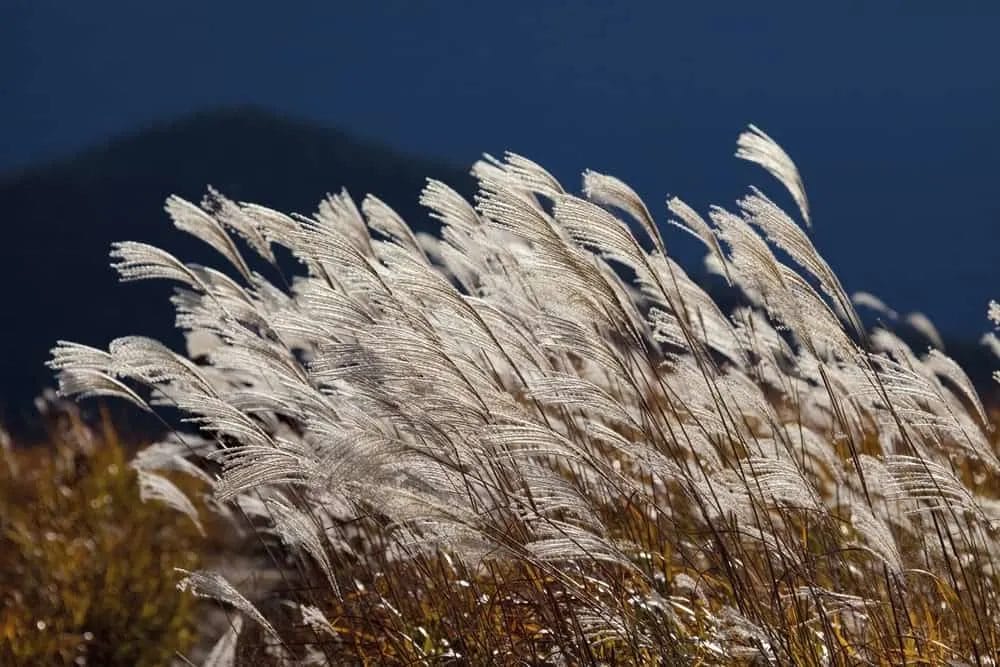
To be completely honest, maintaining a summer garden in hot climates is not always the idyllic experience we envision. It requires a significant amount of labor. However, there is a low-maintenance alternative that allows you to relax in the cool shade, sipping drinks and relishing in your carefully crafted surroundings – grasses.
Are you looking for a unique plant to add some flair to your garden stroll? Perhaps your rock garden could use a touch of excitement, or your prized container garden needs some filler. If you have a lightweight screen that requires some height, there is an ornamental grass variety suitable for all your needs.
Not only are beautiful gardens aesthetically pleasing, but they also require minimal effort to upkeep. Take a moment to unwind and savor the summer as it was intended to be experienced.
A Concise Guide for Caring for Ornamental Grasses
There is a diverse range of shapes and sizes available for ornamental grasses, making them suitable for various occasions and areas within your garden. This statement holds particularly true for ornamental grasses.
The watering routine for your ornamental grass may vary depending on its type and intended use. While certain grasses can thrive with infrequent watering, others may benefit from being thoroughly soaked along with your other plants.
These types of grasses can grow well in soil that has good drainage and do not need frequent fertilization. As long as they are planted in high-quality and balanced soil, they can thrive for an extended period of time without the need for fertilizer. Furthermore, it is important for your summer grasses to receive ample sunlight in order to flourish.
Each year, deciduous grasses will require pruning, whereas evergreen grasses should be trimmed every few years. For a thorough pruning, cut the stems to about one inch above ground level. This will ensure that your deciduous grasses will have their best appearance in the upcoming season. To get rid of any dead or old leaves, simply trim the evergreens and brush them off.
For your summer garden, let’s discuss the top choices for ornamental grasses.
1. Blue Fescue
Blue Fescue is a type of ornamental grass that is known for its striking blue color.
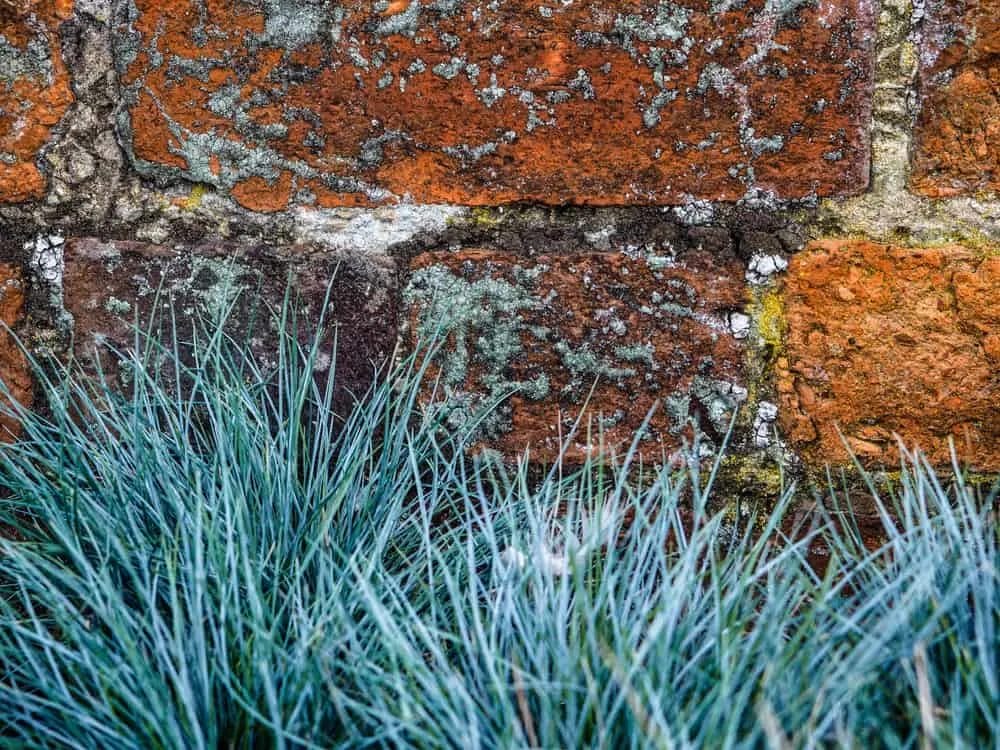
Blue Fescue, a visually appealing grass, has a vibrant hue and grows rapidly while needing little maintenance. It is well-suited for use in containers, pots, or as a border due to its clumping nature.
The ornamental grass, Blue Fescue, can thrive in full sun to partial shade when planted alongside various perennial plants. Its greenish-yellow flowers, when paired with larger leaves, create a visually interesting display. As long as the soil is well-draining and not waterlogged, this grass will flourish.
This grass is well-known for its ability to withstand drought, however, prolonged dry periods can hinder its growth. To ensure the health and happiness of blue fescue in hot weather, it should be watered at least once every seven days.
Blue fescue thrives in USDA hardiness zones 4-8, with the optimal conditions being cooler summers. However, it is able to withstand high temperatures as well.
2. Zebra Grass
Zebra grass, also referred to as porcupine grass, has the ability to give any space a unique and tropical look. Its strikingly large leaves create a stunning contrast with its elongated, yellow and green striped blades. For added privacy and variety in your hedges, consider incorporating this plant in your hedges.

This decorative grass is perfect for the low-maintenance gardener due to its ability to thrive in various soil types, such as clay, loam, and sandy. This makes it an ideal choice for challenging areas in your garden.
Zebra grass flourishes in areas with hot climates and requires full sun exposure. It can thrive in USDA zones 5-9, as long as the temperature ranges from 70 to 90 degrees.
After planting, it is important to give zebra grass regular deep watering in order for its roots to grow. However, once it has established, the frequency of watering can be reduced as this grass is able to withstand periods of drought.
3. Pink Muhly Grass
Pink muhly grass is a low-maintenance type of grass that is easy to take care of. This plant can reach up to three feet in height and creates a beautiful display, particularly towards the end of summer. Its dark green leaves transform into delicate pink flowers with a soft, fuzzy appearance as the season comes to a close. It’s almost like a farewell to the summer season.
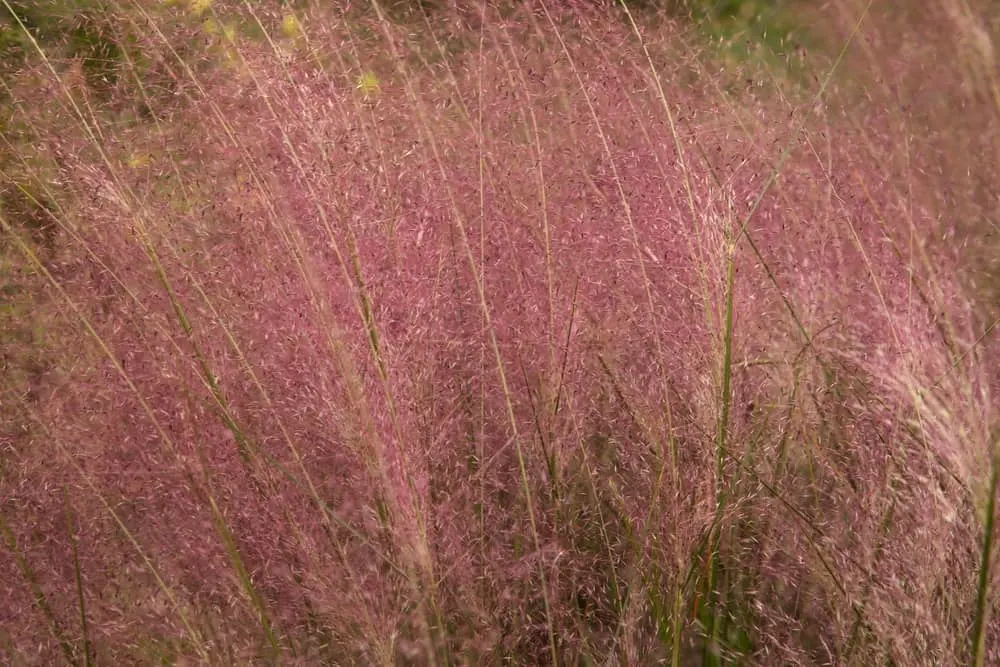
This particular type of grass needs a daily exposure of six to eight hours to sunlight, and it flourishes when placed in a sunny environment. It also produces beautiful pink flowers that are able to blossom even in areas with partial shade.
For pink muhly grass to thrive, it needs soil that drains well. Once it has taken root, this species can withstand periods of drought and does not require frequent watering. However, if the soil is very dry, it may benefit from a quick watering, especially near its roots.
The adaptability of this plant extends beyond its laid-back demeanor. It thrives in various settings, particularly in dry and warm weather. Only extreme cold or excessively humid conditions are unsuitable for its growth.
4. Mexican Feather Grass
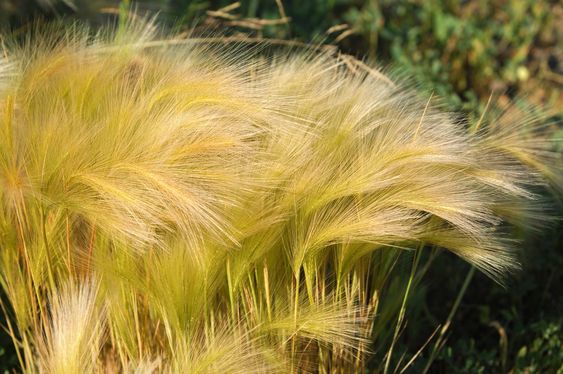
There are many individuals who appreciate this ornamental type of grass, although I prefer to keep this a secret from them. The delicate and wispy leaves of this grass are commonly seen in scenic environments. It can withstand dry conditions once fully grown and thrives in various environments.
The cultivation of Mexican feather grass is possible in almost any location, as it can add height and bring about captivating motion no matter where it is planted.
The USDA recommends zones 7-10 as the most suitable for cultivating Mexican feather grass, as it prefers abundant sunlight and higher temperatures. While intense heat may cause the grass to lose its color, it will not wither. It is important to have well-draining loamy soil for optimal growth.
This plant is ideal for those who forget to water consistently, as it has moderate water needs. Once it is established, it can withstand periods of drought, and occasional missed watering will not affect its appearance.
Mexican feather grass has a significant drawback of its easy spread. This can result in a large number of seeds in your garden. While it is regarded as an invasive plant in certain areas, regular maintenance can help keep it contained in others.
In spite of this obstacle, the attractiveness of this grass justifies the effort to persist with it.
5. Blue Oat Grass
Blue oat grass is an ideal choice for individuals who experience cooler summers. Its unique silver-blue foliage adds a fountain-like element to any garden setting. Whether used in rock gardens or as a border for larger beds, blue oat grass adds a touch of sparkle. During the summer months, it produces stunning blue flowers that perfectly complement its captivating leaves.
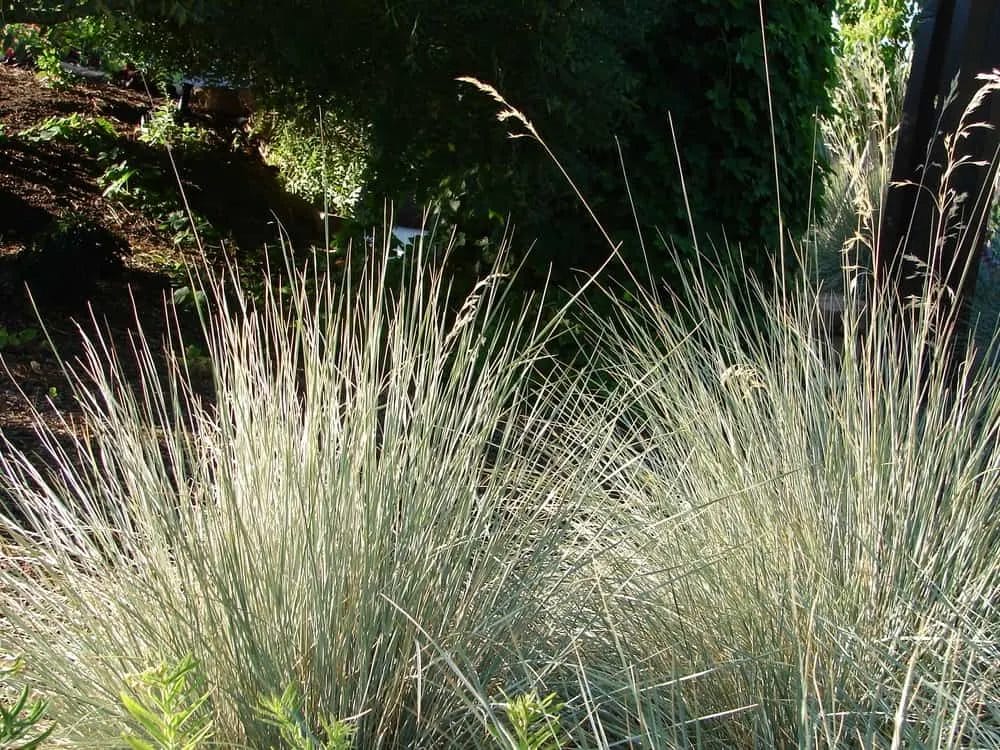
According to its growing requirements, blue oat grass needs to be exposed to full sun for at least six hours daily. It flourishes in dryer and slightly colder conditions, specifically in USDA zones 4-9. However, it can also endure warmer summer temperatures, although this may hinder its maximum growth potential.
This type of ornamental grass grows well in soil that is dry and has proper drainage, thus reducing the need for frequent watering. In certain areas, it can even sustain itself solely on rainwater. Regularly check the condition of the soil and only water when necessary to ensure the plant’s well-being.
6. Purple Fountain Grass
Purple fountain grass is a popular choice among landscapers due to its visually striking appearance. Its purple-red plumes resemble a fountain and provide a beautiful contrast to any type of decoration, whether viewed from a distance or up close.
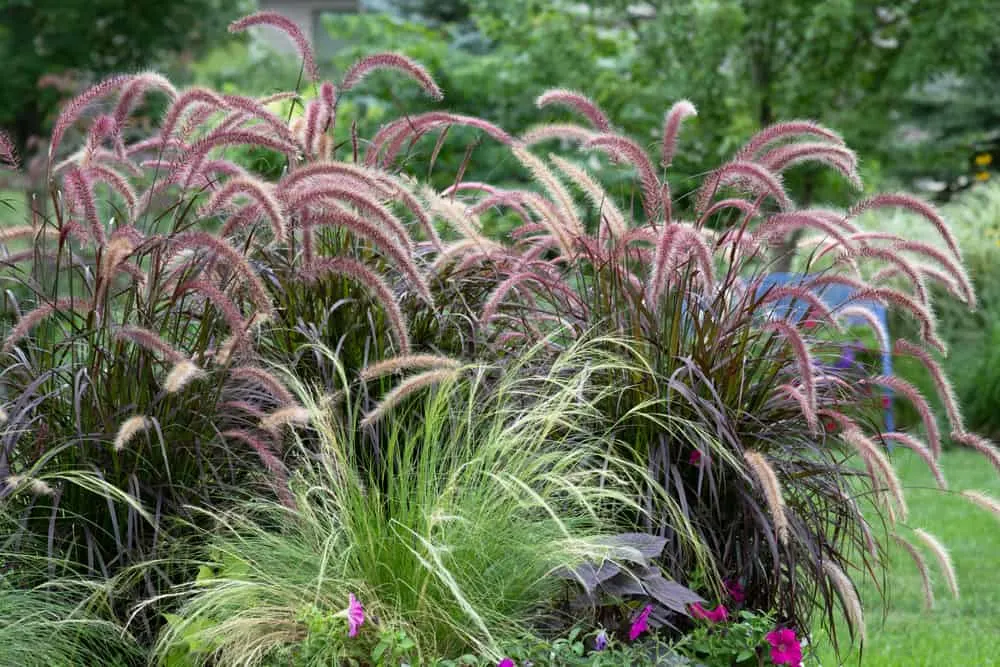
An ideal plant for a compact privacy screen, it also serves well in container gardens by providing texture and height to the overall arrangement.
Growing this plant is an easy task. The Purple Fountain Grass can flourish in USDA zones 8 to 11 and can also withstand varying temperatures. In colder regions, it can be grown as an annual plant. Additionally, this grass is not picky when it comes to humidity levels, making it even better.
After being established, this ornamental grass has the ability to withstand drought and will require watering only once a week in the absence of rainfall. During the initial growth period in your garden, it is recommended to water twice a week to promote root development, but afterwards, watering once every week or two will suffice.
Purple fountain grass has a specific preference when it comes to sunlight, as it requires a certain amount to thrive. This makes it a perfect addition to summer gardens, as it flourishes with a minimum of six hours of sunlight per day.
7. Japanese Blood Grass
Gardens with Japanese blood grass have a unique touch. Whether in container gardens or in open spaces, its vivid combination of red, yellow, and green leaves makes a striking statement. This plant is highly adaptable and can thrive in a variety of environments, making it easy to grow.
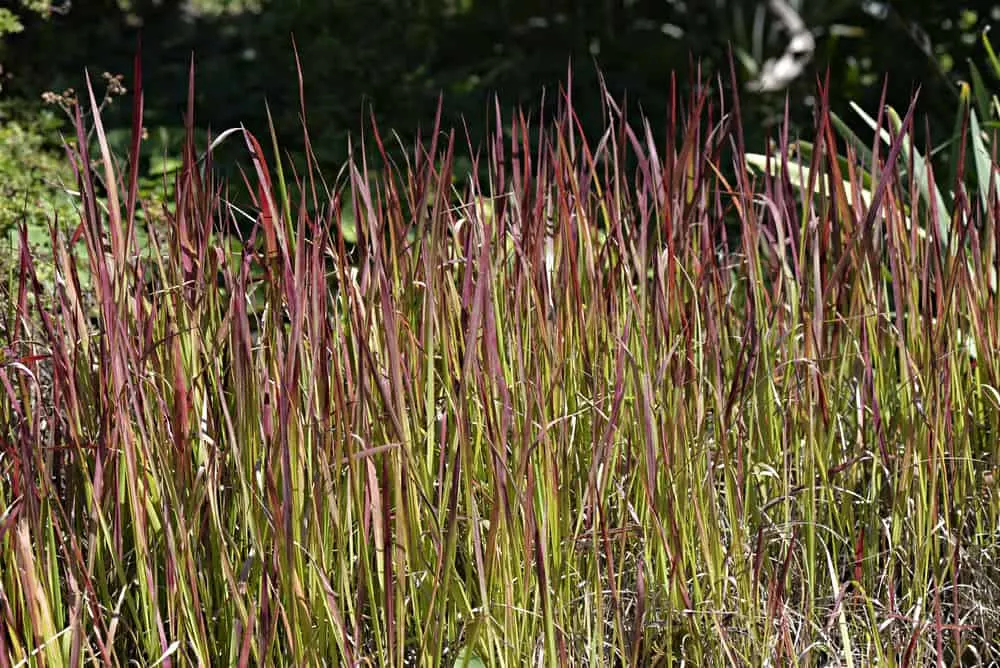
Japanese blood grass is a hardy perennial that is well-suited for USDA zones 5-9 and is known for its rapid growth and resilience in hot climates. This plant is particularly well-adapted to coastal regions, where the high levels of humidity contribute to its thriving nature.
The grass, which can withstand sandy soils, is not picky when it comes to its soil. It is able to withstand periods of drought and can thrive even with infrequent watering.
It is important for gardeners to exercise caution when purchasing particular cultivars, even though they may offer advantages. I am not overstating when I mention their tendency to rapidly spread. In many areas of the United States, a license is required for cultivation. To err on the side of caution, opting for the Rubra cultivar is recommended.
8. Japanese Silver Grass
Eulalia grass, commonly known as Japanese silver grass, is a well-liked type of grass that grows in clumps. Its delicate seed heads add a graceful touch to any surrounding. The tall, erect stems are visually appealing even without their feather-like plumes during the winter season. These grasses are perfect for creating privacy screens and borders, but wherever they are planted, they will surely draw attention as a striking centerpiece.
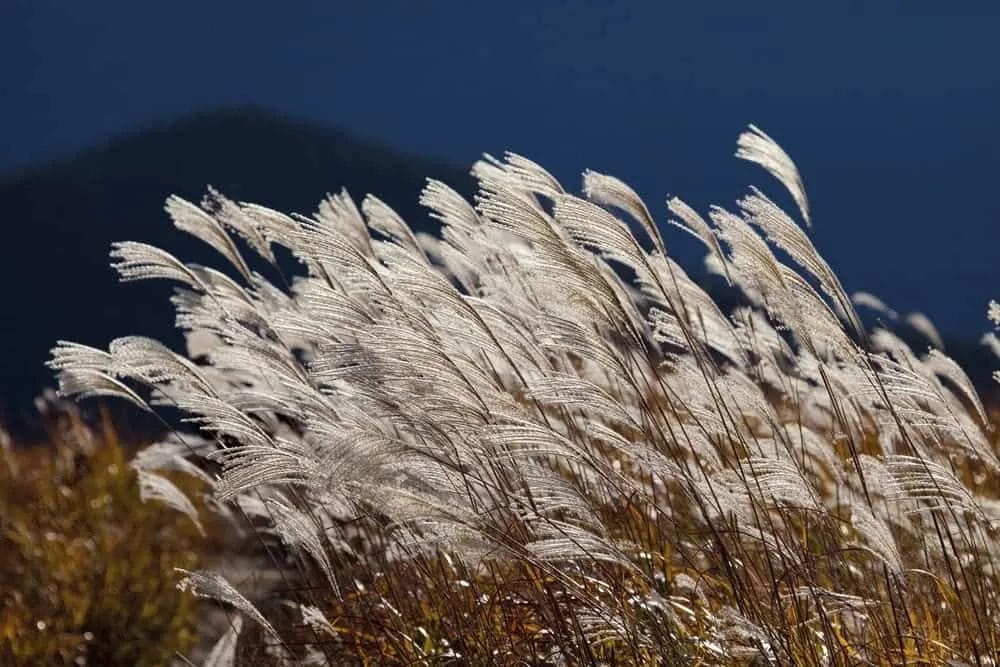
The ideal climate for Japanese silver grass is in warm zones with temperatures higher than chilly zones, specifically in zones 5-9. This type of grass thrives in areas with plenty of sunlight, although it is also capable of tolerating some shade. If you want to fully benefit from the advantages of this grass, it is recommended to have a sunny spot in your garden.
This ornamental grass is not selective as long as the soil has good drainage. It thrives in moist and loamy soil, making it a safe choice. To maintain the ideal moisture level, it is important to water your Japanese silver grass adequately without causing waterlogging, which is a common issue with many garden plants.
9. Japanese Forest Grass
Japanese forest grass is an ideal option for both containers and border plantings, as it puts on a stunning show with its golden hue. Its foliage boasts dark green stripes and a golden tint, ensuring a unique and eye-catching display no matter where it is placed.
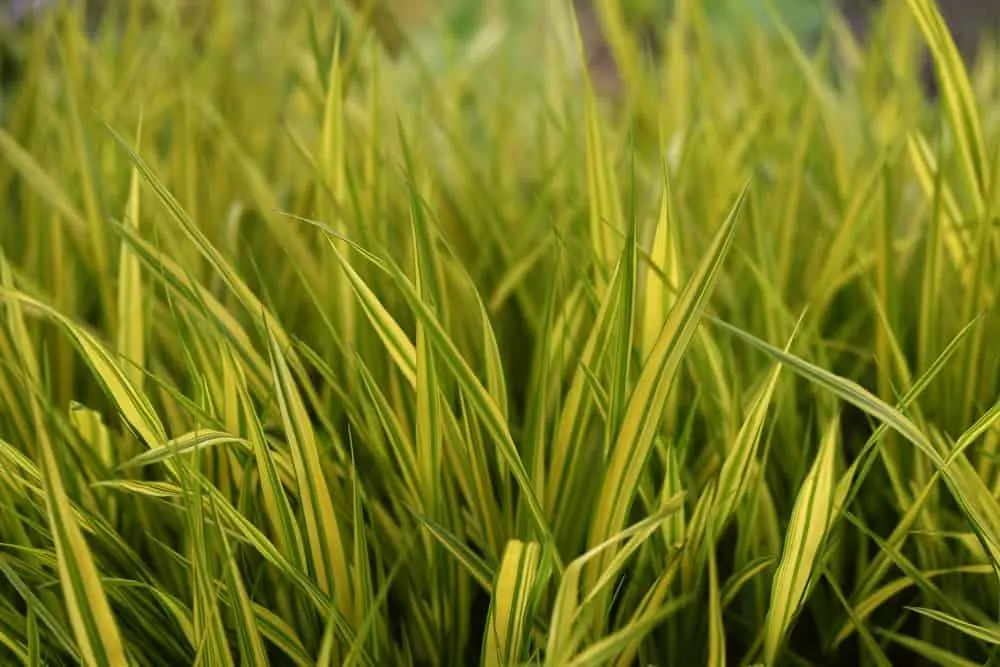
The growth of Japanese forest grass is optimal in areas with partial shade, which sets it apart from most other decorative grasses. While it can tolerate both full shade and sun, the intensity of its colors may diminish. Excessive shade can cause the leaves to turn completely green, while excessive sunlight may result in browned tips.
Japanese forest grass is most suitable for hardiness zones 5-9, as it has the ability to endure all types of weather and temperatures found within these zones.
The fact that this plant thrives in wet soil is just one of its unique characteristics. While it still requires well-draining soil with nutrients, it may require extra watering during the peak of summer. To assist in retaining moisture, it is recommended to add mulch around the plant.
One potential downside of this beautiful plant is its slow growth rate. Although it may not be ideal for those who are impatient when it comes to gardening, it can be a viable choice for individuals who are willing to be patient.
10. Northern Sea Oats
If you have a pond or water feature, you may want to consider adding Northern sea oats. This type of grass has eye-catching flat, green seed heads that bear a striking resemblance to wheat. Its bamboo-like leaves also add a unique texture to the edge of your pond.
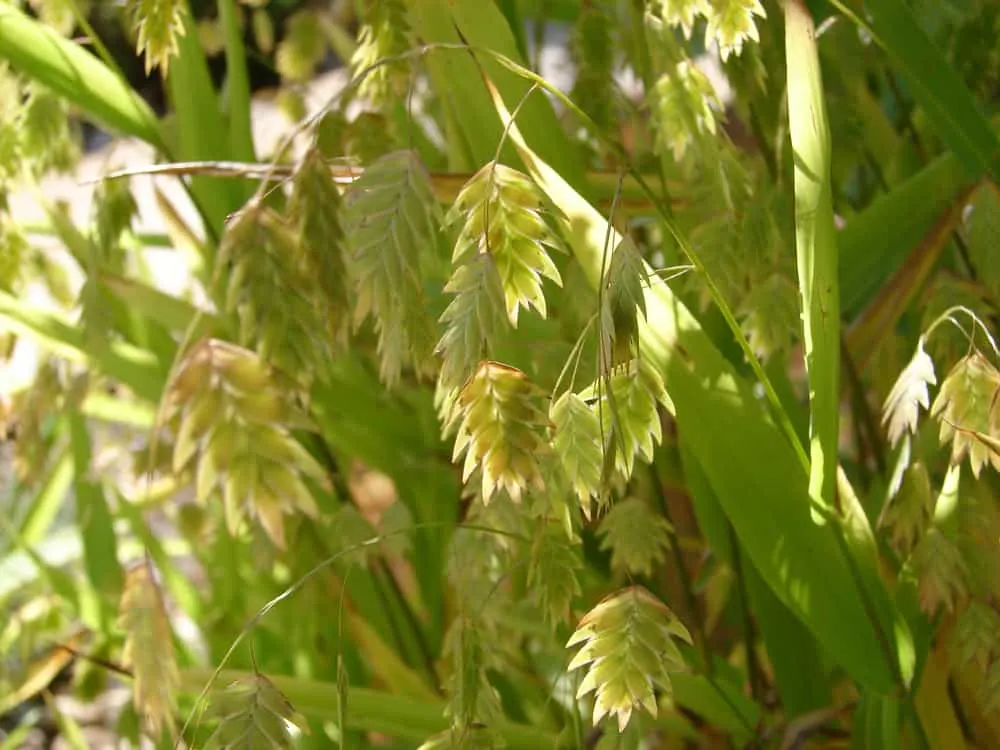
Northern sea oats thrive in USDA zones 5-9 and thrive in full sun. The type of soil is not a major factor, as long as it is nutrient-rich. These grasses are known for their adaptability to both moist and arid conditions, which may come as a surprise.
To successfully cultivate northern sea oats as a ground plant, it is important to have soil that drains well and to follow the same watering schedule as the rest of your garden.
No matter what kind of summer garden you possess, there is an option of using ornamental grass. These grasses can serve as fillers for container gardens or as edging pieces, making them versatile. They are also low maintenance, making them suitable for busy gardeners. With a selection of ten different grasses, your garden can have year-round diversity, even during the hot summer months.